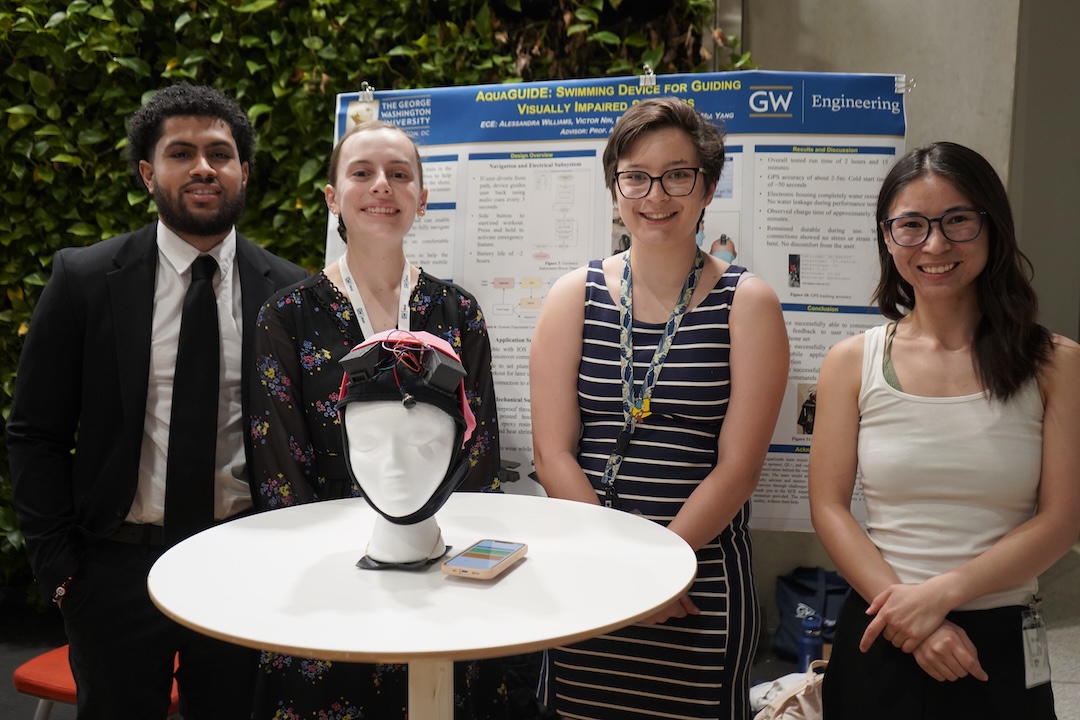AquaGUIDE

Project Team
Caroline Mosko
Victor Nin
Mia Yang
Alessandra Williams
Project sponsor(s)
Quality of Life (QL) Plus
Instructor(s)
Dr. Amir Aslani, ECE, GW Engineering
Dr. HyungSok Choe, BME, GW Engineering
Visually impaired swimmers face significant challenges when trying to swim independently, especially in open water. Current solutions rely heavily on third-party assistance, such as a “tapper” who provides physical signals for turns and path correction. However, this method is not feasible in open-water environments and limits the swimmer’s autonomy. There are also no widely available tools to help visually impaired swimmers maintain a straight path without external help. Our project addresses this issue by developing a swim cap—AquaGUIDE—that uses GPS and IMU technology to guide swimmers through audio feedback, allowing them to swim independently and safely without relying on another person.
Who experiences the problem?
This problem is primarily experienced by individuals who are blind or visually impaired, particularly those with an interest in swimming for recreation, competition, or fitness. Many of these individuals face barriers when it comes to swimming independently due to their reliance on tappers or specialized support, which are not always accessible. One such individual, Mike Nelson, a veteran with service-related vision loss, inspired the development of this solution through his desire to swim safely and independently in open water. More broadly, visually impaired athletes around the world encounter similar limitations that this project aims to address.
Why is it important?
The lack of independence for visually impaired swimmers is a significant barrier to physical activity, inclusion, and personal empowerment. Swimming is not only a vital form of exercise but also a source of confidence and freedom. Without accessible tools for navigation and safety, many visually impaired individuals are excluded from enjoying or competing in aquatic sports. AquaGUIDE tackles this by providing a low-cost, accessible, and innovative solution that promotes autonomy and inclusivity. Additionally, it reduces dependence on others, expands opportunities for fitness and competition, and enhances safety—especially in settings like lakes or oceans where third-party guidance is not practical.
What is the coolest thing about your project?
The coolest part of our project is the mobile app, which empowers visually impaired swimmers to independently set up and track their workouts—something that was previously difficult or impossible without sighted assistance. Through a clean, accessible interface that integrates with Apple’s VoiceOver, users can enter lap distances and reps before the swim, and afterward, the app stores a summary of performance data including total distance and swim time. This not only enhances autonomy, but also gives users a way to monitor progress over time. On top of the technical challenge, the chance to help a veteran like Mike regain independence in a sport he loves makes this project incredibly rewarding.
What were some technical challenges?
Processing IMU data presented one of the most technically challenging aspects of this project. Although IMUs can estimate displacement through double integration, this approach is highly sensitive to noise and drift. To address this, we explored methods like Kalman filtering and PyPose-based fusion with GPS data to improve orientation tracking and short-term position correction during GPS signal loss. Even when full displacement estimation wasn't feasible, the IMU remained essential for determining heading and detecting swimmer movement, especially during turns. Another challenge involved implementing underwater text-to-speech cues that remained intelligible through bone conduction headphones. Fine-tuning volume, phrasing, and timing to work well above and below water while keeping power consumption low required significant iteration. Lastly, maintaining a stable Bluetooth connection and ensuring reliable data synchronization between the cap and the mobile app introduced additional debugging and compatibility issues.

